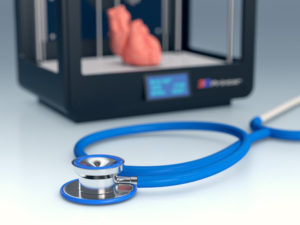Adult Stem Cell Therapy & Platelet Rich Plasma
The Future of 3D Printing in Orthopedics
 Just like stem cell therapy, 3-D printing is another technological advancement that is taking the healthcare world by storm. What began as a neat toy for tech enthusiasts has evolved into a critical element of success in medical specialties ranging from dentistry and cardiology to the separation of conjoined twins. In fact, the FDA has now approved more than 85 devices made using 3D printers. This means that the future of 3D printing in orthopedics is shining bright.
Just like stem cell therapy, 3-D printing is another technological advancement that is taking the healthcare world by storm. What began as a neat toy for tech enthusiasts has evolved into a critical element of success in medical specialties ranging from dentistry and cardiology to the separation of conjoined twins. In fact, the FDA has now approved more than 85 devices made using 3D printers. This means that the future of 3D printing in orthopedics is shining bright.
An Introduction to 3-D Printing
Originally known as Additive Manufacturing, 3D printing creates objects by printing layers of materials on top of one another. This creates a three dimensional result that can be held, manipulated, and studied. In many cases, the 3-D-printed version of a product is more fluid, organic, and structurally sound than the same product manufactured traditionally. Examples include customized implants, teeth, hearing aids, and prosthetics.
The power of 3-D printing has allowed incredible medical achievements that were previously impossible. For example, experts have developed 3-D-printed airway splints for babies with tracheobronchomalacia, a condition that makes the delicate airways around the lungs prone to collapsing. These 3D-printed airway splints are designed to grow with the young patient and have been successfully tested in three infants. At a cost of only $10 a unit, the 3-D-printed solution completely transforms what families are able to afford and how efficiently doctors can treat patients in need.
3-D Printing in Orthopedics
The immediate value of 3-D printing in orthopedics can be found in the models that 3-D printing creates. Orthopedic surgeons can use 3D printers to create precise models of the joints or bones that they will be repairing, allowing them to produce patient-specific surgical guides. This type of surgical planning can make all the difference in a patient’s recovery.
Orthopedic surgeons can also use 3D printing to create implants that are precisely tailored to individual patients. For example, a patient with dwarfism may need a total hip arthroplasty with hip implants smaller than those traditionally available. Current 3-D printing technology makes it quick, easy, and affordable to develop implants that are customized to unique patients.
These 3-D printing applications in orthopedics are just the beginning of the uses for such a transformative technology.







This article gives clear idea in favor of the new viewers of blogging, that genuinely
how to do running a blog.
For newest information you have to pay a visit the web and on world-wide-web I found this website
as a finest site for newest updates.
An interesting discussion is worth comment.
I believe that you should write more about this subject, it might not be a taboo subject
but generally people don’t discuss these
issues. To the next! All the best!!